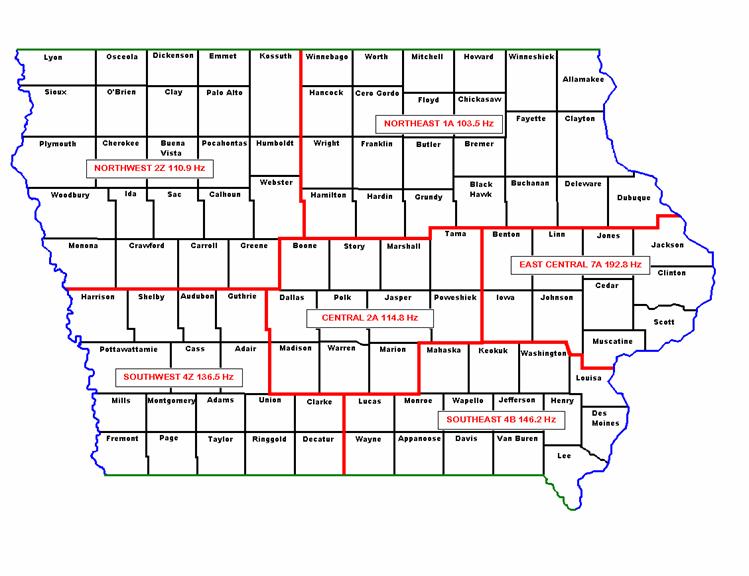REGIONAL SUB-AUDIBLE TONE PLAN
Historically, the six zones were set up to accommodate the 146.22-82 and 146.34-94 frequency pairs, as there were repeaters on those frequencies in at least five of the six zones at that time. (It should be noted that these zones DO NOT MATCH those set up by the ARRL for use in their Repeater Directory.) The tones chosen for each respective zone were selected on criteria springing from the Wisconsin plan and those currently in use by repeaters in each zone.
While the Iowa Repeater Council, Inc., recommends use of the tone assigned to your geographic area, each Trustee needs to decide which tone to use, hopefully staying away from those in use in other areas. The original idea was developed when changing tones meant getting inside the radio and changing reeds – not an easy task – so the plan was such that you could use the same tone in your “home” area, switch to a different repeater and not have to change reeds. With the advent of the newer radios, some of this has become moot, as changing tones is as easy as punching different key sequences and most radios come equipped for tone use, both encode and decode.
As with all coordination data, the Coordinator cannot protect what he does not know, so keeping him informed of your choices of operating parameters, i.e., tone, etc., would be highly recommended! As tone choice is not one of the five primary coordination criteria, you may change your tone at will, but it is always wise to check with the Coordinator to avoid choosing a tone already in use nearby on the same channel, in-state or out-of-state.
The five primary coordination criteria are: ownership, frequency, Lat/Lon, HAAT, and ERP. Guidelines have traditionally been: ownership – if the repeater is sold, it needs to be re-coordinated. If it is owned by a club, trustee change does not engender re-coordination, but the Coordinator should be apprised of any change of callsign and contact information. Frequency – a no-brainer, as this is our most precious and scarce resource. Lat/Lon – or “location, location, location” to quote the real estate folks. Many times the choice of frequency is critical in regards to the location of the proposed/existing repeater. Moving it BEFORE consulting with the Coordinator might necessitate choosing a different frequency and the ensuing costs that entails! HAAT/ERP – We attempt to keep track of this on all repeaters (you are supposed to have it calculated and entered in your repeater logbook!), and allow you to run anything less than that coordinated without a re-coordination. At some point, it may be necessary to make coordination decisions based on these data, but for the most part, we have not had to do so.

